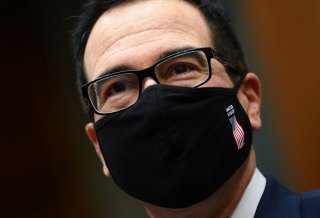America's Next Anti-Coronavirus Stimulus Should Include a Back-To-Work Bonus
Here's how to help average Americans and the economy.
As part of the Phase 4 coronavirus stimulus bill, Republican Senator Rob Portman of Ohio recently proposed that Congress should implement a back-to-work bonus that pays workers who were laid off and subsequently return to work a payment of $450 for each week that they work through July 31. He suggested that the payment should be retroactive. Unemployment benefits from the Coronavirus Aid, Relief, and Economic Security (CARES) Act were very generous and raised the incomes of many recipients when compared to what they were earning before they were laid off. This reduced incentives to return to work. A back-to-work bonus would increase the incentive for those currently unemployed to go back to work as soon as they have the opportunity to do so.
If the goal is to reduce the unemployment rate and hasten economic recovery, some kind of back-to-work bonus is better than extending federal unemployment benefits.
The unemployment rate has been falling, but it’s still high. The official unemployment rate was 11.1 percent in June. A more comprehensive measurement, which includes those marginally attached to the labor force and those employed part-time for economic reasons, puts the figure at 18 percent in June.
If Congress doesn’t extend the CARES Act unemployment benefit beyond July 31, workers will have a powerful incentive to return to work after that date. But before that date, without the $450 weekly bonus, many furloughed workers get paid more by remaining unemployed. As a result, many businesses that are trying to reopen have had difficulty finding enough workers to fill all of their positions.
For example, a company that works with local chefs in Oregon to open and operate restaurants wanted to hire some workers to help with the growing demand for take-out and delivery orders. They found that very few furloughed workers were willing to return to work because they get paid more in state and federal unemployment compensation than they could earn from working.
The state of Idaho has already enacted a back-to-work bonus. The state is offering a one-time payment of $1,500 for full-time workers and $750 for part-time workers who returned to work between May 1 and July 1 and continue to work for at least four weeks. These benefits are available to anyone who applied for and received Idaho unemployment benefits on or after March 1.
Proponents of continued federal unemployment assistance after July 31 argue that there aren’t enough job openings for all of those who are unemployed. The Bureau of Labor Statistics reported that 17.8 million were unemployed in June, yet there were only 5.4 million job openings at the end of May. An additional 8.2 million were not in the labor force but wanted a job.
The number unemployed includes 10.6 million who were temporarily laid off, so many of them should be able to return to their existing jobs. Although there are fewer job openings than the number who have permanently lost their former jobs, as the economy continues to recover, more jobs will open up.
Almost all of those who remain unemployed after July 31 can continue to receive a check from their state unemployment insurance fund through at least December 31, 2020. All states provide up to thirty-nine weeks of benefits. In most states, workers will be eligible for an additional thirteen weeks of benefits if the unemployment rate is high enough.
According to the Congressional Budget Office (CBO), if the federal benefit of $600 per week were extended to January 2021, “benefits would exceed 100 percent of potential earnings for roughly five of every six recipients of unemployment benefits.” State benefits by themselves are less than prior earnings. So, without the additional federal benefits, unemployed workers would have an incentive to accept the jobs offered to them, because doing so usually increases their income by a substantial amount.
The CBO projects that if the $600-per-week benefit expires at the end of July, employment would be higher for the rest of 2020 and for 2021 than if the benefit is extended until January 2021. If it is extended and expires in January 2021, many of the unemployed will be less likely to find and accept a job in late 2020. As a result, they may remain unemployed for at least part of 2021 before getting another job offer.
Extending federal unemployment benefits past July 31 would cost the government billions of additional dollars and could slow the economic recovery by reducing incentives to return to work. The CBO also notes that if the federal government spends more to extend unemployment benefits, the resulting larger deficits will reduce the long-term sustainable rate of output for the economy, thereby lowering standards of living.
Spending on large-scale testing and contact tracing may be necessary as part of the Phase 4 stimulus, so people can safely return to work, especially in the hospitality and leisure sectors of the economy. But a return-to-work bonus could play an important role.
Tracy C. Miller is a senior policy research editor with the Mercatus Center at George Mason University.
Image: Reuters

